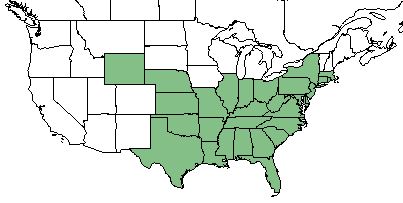Smilax glauca
Common name: whiteleaf greenbriar [1], wild sarsaparilla [1], cat greenbriar [2]
| Smilax glauca | |
|---|---|

| |
| Photo by John Gwaltney hosted at Southeastern Flora.com | |
| Scientific classification | |
| Kingdom: | Plantae |
| Division: | Magnoliophyta - Flowering plants |
| Class: | Liliopsida - Moncots |
| Order: | Liliales |
| Family: | Smilacaceae |
| Genus: | Smilax |
| Species: | S. glauca |
| Binomial name | |
| Smilax glauca Walter | |

| |
| Natural range of Smilax glauca from USDA NRCS Plants Database. | |
Contents
Taxonomic Notes
Synonyms: S. glauca var. leurophylla Blake
Varieties: none
Description
S. glauca is a perennial shrub/vine of the Smilacaceae family native to North America. [2]
Distribution
S. glauca is found in the southeastern corner of the United States from Wyoming to Massachusetts. [2]
Ecology
Habitat
S. glauca proliferates in a wide variety of upland and wetland habitats. [1] S. glauca responds negatively to agricultural-based soil disturbance in South Carolina coastal plain communities. This marks it as a possible indicator species for remnant woodland.[3][4] It exhibits no response to soil disturbance by improvement logging in Mississippi.[5]
Specimens have been collected from drying loamy sand, mesic woodland, cedar swamp, and bottomland hardwood. [6]
Phenology
S. glauca has been observed to flower April through May. [7]
Seed dispersal
This species is thought to be dispersed by consumption by vertebrates. [8]
Fire ecology
S. glauca is not fire resistant, but has a high fire tolerance. [2]
Use by animals
S. glauca has high palatability for browsing animals, but low palatability for grazing animals. [2]
Conservation and Management
Cultivation and restoration
Photo Gallery
References and notes
- ↑ 1.0 1.1 1.2 Weakley, A. S. (2015). Flora of the Southern and Mid-Atlantic States. Chapel Hill, NC, University of North Carolina Herbarium.
- ↑ 2.0 2.1 2.2 2.3 2.4 USDA Plant Database https://plants.usda.gov/core/profile?symbol=SMGL
- ↑ Brudvig, L.A., E Grman, C.W. Habeck, and J.A. Ledvina. (2013). Strong legacy of agricultural land use on soils and understory plant communities in longleaf pine woodlands. Forest Ecology and Management 310: 944-955.
- ↑ Brudvig, L.A., J.L. Orrock, E.I. Damschen, C.D. Collins, P.G. Hahn, W.B. Mattingly, J.W. Veldman, and J.L. Walker. (2014). Land-Use History and Contemporary Management Inform an Ecological Reference Model for Longleaf Pine Woodland Understory Plant Communities. PLoS ONE 9(1): e86604.
- ↑ McComb, W.C. and R.E. Noble. (1982). Response of Understory Vegetation to Improvement Cutting and Physiographic Site in Two Mid-South Forest Stands. Southern Appalachian Botanical Society 47(1):60-77.
- ↑ URL: http://herbarium.bio.fsu.edu. Last accessed: June 2018. Collectors: Loran C. Anderson, R.K. Godfrey, R. Komarek, Andre F. Clewell, Chris Cooksey, Cecil SLaughter, Marc Minno, Bob Fewster, William Platt, Richard Carter, M. Darst, H. Light, L. Peed. States and counties: Florida (Levy, Washington, Flagler, Leon, Calhoun, Wakulla) Georgia (Thomas, Grady, Taylor)
- ↑ PNelson, G. PanFlora: Plant data for the eastern United States with emphasis on the Southeastern Coastal Plains, Florida, and the Florida Panhandle. www.gilnelson.com/PanFlora/ Accessed: 29 MAY 2018
- ↑ Kirkman, L. Katherine. Unpublished database of seed dispersal mode of plants found in Coastal Plain longleaf pine-grasslands of the Jones Ecological Research Center, Georgia.